- Details
- Hits: 868
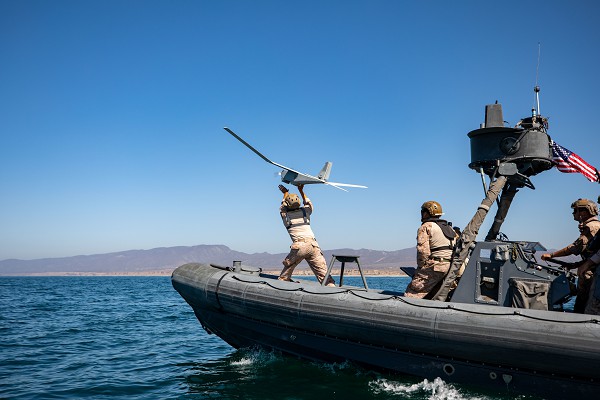 Camp Pendleton, CA. (October 22, 2022): In this photo by Staff Sergeant Connor Hancock, U.S. Marine Corps Corporal Thomas Rexrode launches an RQ-20B PUMA Small Unmanned Aircraft system from a rigid-hulled inflatable boat to test offshore reconnaissance capabilities. Corporal Hancock is a Recon Marine assigned to A Company, 1st Recon Battalion, 1st Marine Division.
Camp Pendleton, CA. (October 22, 2022): In this photo by Staff Sergeant Connor Hancock, U.S. Marine Corps Corporal Thomas Rexrode launches an RQ-20B PUMA Small Unmanned Aircraft system from a rigid-hulled inflatable boat to test offshore reconnaissance capabilities. Corporal Hancock is a Recon Marine assigned to A Company, 1st Recon Battalion, 1st Marine Division.
Camp Pendleton, CA. (October 22, 2022): During WWII, allied forces landed on the beaches of Normandy with very little idea of what they would face when they reached the beach. Intelligence was scarce, save for a few French resistance reports, and assessments of enemy troop positions was sketchy, at best. The Allies were going in blind.
In today’s technological age, American servicemembers no longer depend upon luck and local informants to assess enemy strength before an invasion, they have the PUMA on their side.
Officially named the Pointer Upgraded Mission Ability (PUMA), this unmanned arial vehicle resembles the hand launched balsa wood toys of our youth and it can be deployed from Navy ships or even small inflatables (See photo above) to scout landing sites for trouble. Developed by AeroVironment, the PUMA gathers tactical intelligence, conduct surveillance and reconnaissance, identify targets, maritime patrol, search and rescue, and counter-illicit trafficking missions. The PUMA features a light airframe weighing only fourteen pounds and has a 3-foot wingspan that can easily be assembled and launched by two people.
Read more: RELEASE THE “PUMA”… MARINES LAUNCH “EYES & EARS” TO SCOUT BEACH LANDINGS
- Details
- Hits: 922
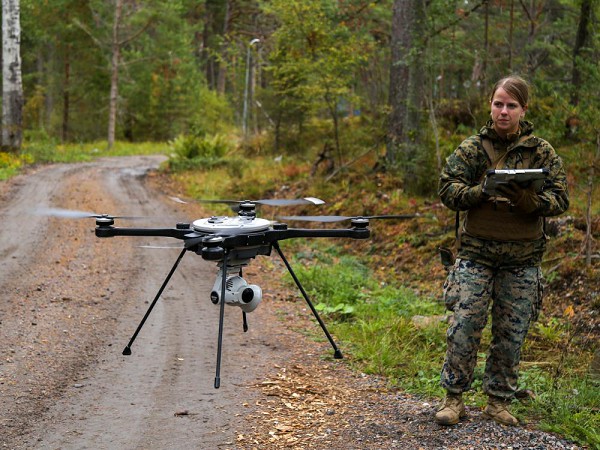 Berga Naval Base, Sweden. (October 28, 202): In this photo by 1st Lieutenant William Reckley, U.S. Marine Corps Sergeant Danielle Grimshaw, an intelligence analyst with the Littoral Engineer Reconnaissance Team, 8th Engineer Support Battalion, deploys a R80D Skyraider unmanned aerial system during Exercise Archipelago Endeavor 22.
Berga Naval Base, Sweden. (October 28, 202): In this photo by 1st Lieutenant William Reckley, U.S. Marine Corps Sergeant Danielle Grimshaw, an intelligence analyst with the Littoral Engineer Reconnaissance Team, 8th Engineer Support Battalion, deploys a R80D Skyraider unmanned aerial system during Exercise Archipelago Endeavor 22.
Berga Naval Base, Sweden. (October 28, 2022): For over two hundred years, Sweden has maintained a strict neutrality in military conflicts by adopting a foreign policy promoting international peace.
Until now.
Sweden abandoned its neutrality in response to the illegal invasion of Ukraine and has applied for NATO membership, a sea change in attitude thanks to Russian Dictator Vladimir Putin. The move has widespread support among the Swedish people with recent surveys indicating 58 percent now support joining the alliance in the face of hostile threats from neighboring Russia.
The last time the Swedes chose sides in times of war stretches back to 1812, when a young America declared war on the British and Napoleon made the unwise decision to invade Russia. Today, American and Swedish Marines train together in exercise Archipelago Endeavor, a series of field maneuvers ranging from water survival techniques to vessel-borne raids and patrols along Sweden’s eastern shore.
Located on the Baltic Sea, Sweden has tens of thousands of mostly uninhabited islands, an ideal playground for U.S. Marines as they practice assault landings with the Swedish Navy. This year, Archipelago Endeavor 22 has united elements of the U.S. 1st Battalion, 6th Marine Regiment, 2nd Marine Division and the Swedish Marines from the 204th Rifle Company, 2nd Marine Battalion, 1st Marine Regiment. These joint forces practice mission planning, sniper tradecraft, machine gun tactics, patrolling, amphibious raid tactics, and the employment of unmanned aerial surveillance systems such as the R80D Skyraider.
The Skyraider is a state-of-the-art unmanned aerial system that U.S. and Swedish forces will deploy in any future conflict with the Russians. The Skyraider is ideal for gathering intelligence on enemy positions, surveillance, reconnaissance, and clandestine operations. The system requires only one operator and carries a variety of payloads up to five pounds. Although classified, the Skyraider is reputed to be powered by the latest in artificial intelligence.
In the event of war with Russia, Sweden would join NATO allies Estonia, Latvia, Lithuania, Poland, Germany, Denmark, and Finland to defend the Baltic Sea region.
As our forces deploy to confront Russian aggression, we need to do everything possible to ease their burden. Please consider donating to Support Our Troops’ Patriot Brigade®, joining thousands of Americans who make monthly donations to pay for comfort items and recreational programs for our military deployed overseas. Go to our secure website https://supportourtroops.org/donate to contribute to America’s finest today!
- Details
- Hits: 1237
 Joint Base Elmendorf-Richardson Alaska.(October 27, 2022): In this photo by Alejandro Pena, soldiers with the 4th Infantry Brigade Combat Team (Airborne), 25th Infantry Division recover a parachute during the sling load training portion of the U.S. Army’s Pathfinder qualifications course hosted by Joint Base Elmendorf-Richardson Alaska. The Army’s Pathfinder School, based at Ft. Benning, Georgia, sends instructors to various units around the world to conduct a three-week intensive course for soldiers who want to be “Always First.”
Joint Base Elmendorf-Richardson Alaska.(October 27, 2022): In this photo by Alejandro Pena, soldiers with the 4th Infantry Brigade Combat Team (Airborne), 25th Infantry Division recover a parachute during the sling load training portion of the U.S. Army’s Pathfinder qualifications course hosted by Joint Base Elmendorf-Richardson Alaska. The Army’s Pathfinder School, based at Ft. Benning, Georgia, sends instructors to various units around the world to conduct a three-week intensive course for soldiers who want to be “Always First.”
Joint Base Elmendorf-Richardson Alaska. (October 27, 2022): They drop from the skies ahead of the main force, deep behind enemy lines, risking their lives so their Airborne comrades land where they are supposed to ready to fight. Their motto is “Semper Primus”… Always First, history knows them as the Pathfinders.
The U.S. Army created the Pathfinders at the beginning of World War II after a series of erratic airborne landings in North Africa and Sicily Italy that dropped soldiers over fifty miles from their intended targets. The Army realized it needed highly specialized soldiers to land in enemy territory before main force units to set up drop zones and to guide invading aircraft to their targets.
To accomplish this, the U.S. Army established its first Pathfinder school in England whose graduates were among the first to land in France in the Normandy Invasion. The Pathfinders landed far inland to mark drop zones for their fellow paratroopers and glider borne infantry while the landings took place all along the Normandy coast.
Read more: ESTABLISHING DROP ZONES… MILITARY PATHFINDERS ARE “ALWAYS FIRST” INTO BATTLE
- Details
- Hits: 1119
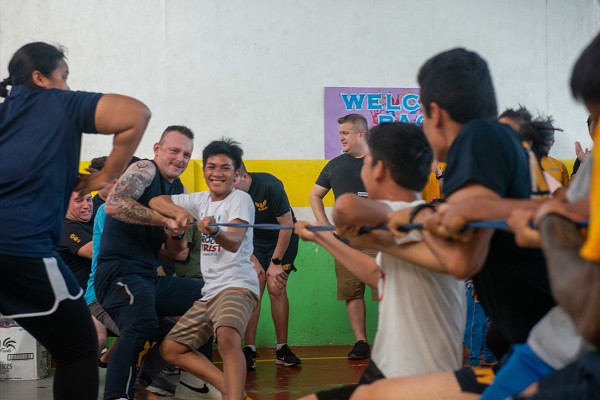 Manila, Philippines. (October 15, 2022): In this photo by Petty Officer 2nd Class Michael Jarmiolowski, Electronics Technician 3rd Class Ian Reynolds, left, from Virginia Beach, Virginia, goes hands on in a tug of war with children at Gentle Hands Orphanage as part of the Navy’s community relations effort. Sailors volunteered for the event to play games and create hand-drawn paintings with over 100 children. The Sailors are assigned to the guided-missile cruiser USS Chancellorsville, part of the Ronald Reagan Carrier Group. Young, enthusiastic Sailors like these often make the best ambassadors for our country.
Manila, Philippines. (October 15, 2022): In this photo by Petty Officer 2nd Class Michael Jarmiolowski, Electronics Technician 3rd Class Ian Reynolds, left, from Virginia Beach, Virginia, goes hands on in a tug of war with children at Gentle Hands Orphanage as part of the Navy’s community relations effort. Sailors volunteered for the event to play games and create hand-drawn paintings with over 100 children. The Sailors are assigned to the guided-missile cruiser USS Chancellorsville, part of the Ronald Reagan Carrier Group. Young, enthusiastic Sailors like these often make the best ambassadors for our country.
Heilbronn, Germany. (October 1, 1978): It was my first week stationed in Germany as an 18-year-old private assigned to the 237th Combat Engineers in a strange and exciting foreign land. I had barely unpacked when a gruff old sergeant appeared asking for volunteers to help local farmers harvest their crops. Although new to the Army, I realized that any troops hanging around the barracks over a weekend would certainly end up with some unpleasant extra duty.
Around 5 a.m. the next day, about thirty of our number fell out for formation and were sent via deuce and a half truck to the vineyards surrounding Heilbronn. None of us had ever picked grapes before so we thought; “How hard could it be?”
The welcoming German farmers quickly strapped huge plastic barrels to our backs and sent us hiking up the hills between rows of grapes as the sun finally broke the horizon. Our job was to walk back down the hill collecting bunches of grapes from what seemed like hundreds of school age kids, and then climb ladders to dump the contents into huge portable vats. It turned out to be back breaking work and some of the most precious moments we ever spent with our German hosts.
- Details
- Hits: 872
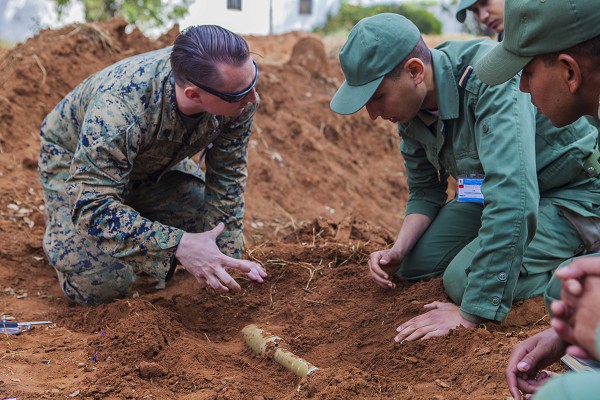 Kenitra, Morocco. (October 20, 2022): In this photo by Captain Clay Groover, a U.S. Marine with Special Purpose Marine Air-Ground Task Force Crisis Response teaches explosive ordnance identification procedures to a member of the Moroccan Royal Armed Forces. As part of its “Humanitarian Diplomacy”, the United States assists critical allies with intractable problems, in this case unexploded mines that threaten their civilian population.
Kenitra, Morocco. (October 20, 2022): In this photo by Captain Clay Groover, a U.S. Marine with Special Purpose Marine Air-Ground Task Force Crisis Response teaches explosive ordnance identification procedures to a member of the Moroccan Royal Armed Forces. As part of its “Humanitarian Diplomacy”, the United States assists critical allies with intractable problems, in this case unexploded mines that threaten their civilian population.
Kenitra, Morocco. (October 20, 2022): Morocco was one of the first countries to recognize the fledgling United States in 1777 and has been one of America’s closest allies ever since. It has the fifth largest economy in Africa and is an influential member of the Arab League and the African Union, two organizations that are often critical to American diplomatic goals in the region. Most importantly, the Moroccans have proven to be a stabilizing force in the tumultuous conflicts besetting the Maghreb Desert.
Along with economic ties (the U.S. recently signed a free-trade agreement with favorable terms for the desert kingdom), American and Moroccan military forces have developed deep ties over the years. An example of this “Humanitarian Diplomacy” is the presence of U.S. Marines assisting the Moroccan Army in dealing with deadly land mines left over from previous conflicts.
- Details
- Hits: 845
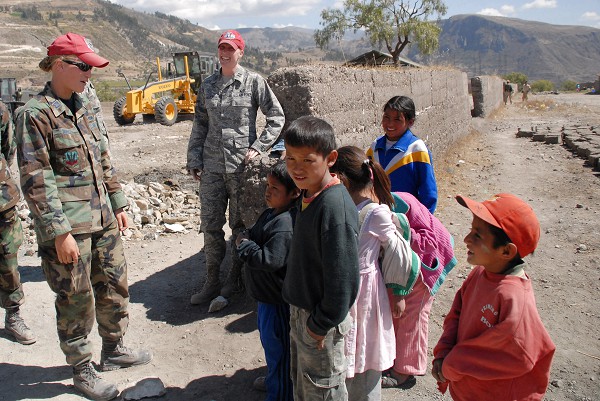 Huamanga, Peru. (October 22, 2022): In this photo by Airmen 1st Class Tracie Forte, Captains Stacy Nimmo and Megan Leitch talk with children during a visit to the construction site for a school being built as part of New Horizons Peru, an event that benefits thousands of Peruvians. Servicemembers from the U.S. Air Force, Army, Marines, and Navy come together to construct schools, clinics, and water wells for Peruvians while building lifelong friendships and comrades. Captains Nimmo and Leitch hail from the 820th RED HORSE Squadron at Nellis Air Force Base, Nevada.
Huamanga, Peru. (October 22, 2022): In this photo by Airmen 1st Class Tracie Forte, Captains Stacy Nimmo and Megan Leitch talk with children during a visit to the construction site for a school being built as part of New Horizons Peru, an event that benefits thousands of Peruvians. Servicemembers from the U.S. Air Force, Army, Marines, and Navy come together to construct schools, clinics, and water wells for Peruvians while building lifelong friendships and comrades. Captains Nimmo and Leitch hail from the 820th RED HORSE Squadron at Nellis Air Force Base, Nevada.
Huamanga, Peru. (October 22, 2022): How can giving humanitarian aid help America win a war?
The very same cooperation and close coordination needed for humanitarian aid projects is vital to success on the battlefield. Coordinating logistics, transportation, and emergency services makes for excellent practice for America’s warfighters while using the power of our military to help those less fortunate.
A classic example are efforts to assist underprivileged communities in Peru (pictured above).
Led by the Air Force’s 820th RED HORSE Squadron, these humanitarian efforts take advantage of expertise from the Army, Navy, and Marine Corps to tackle numerous civic projects. Under the auspices of the U.S. Southern Command, these multi-service relief efforts create bonds and friendships between the U.S. and its southern neighbors. The 50-year-old Southern Command is responsible for the entire land mass of Latin America, the waters adjacent to Central and South America, and the Caribbean Sea. Southern Command exists to deter aggression but also to rapidly respond to crisis in the hemisphere, a tall task indeed. In addition to humanitarian and military defense, the Southern Command plays a major role in drug interdiction efforts in the Caribbean.
The RED HORSE, or Rapid Engineer Deployable Heavy Operational Repair Squadron Engineers, are unique not just for the distinctive red caps they wear, but also for their incredible operational and training capabilities.
Based at Nellis Air Force Base, Nevada, the 820th is one of four active-duty squadrons whose mission is rapidly responding to emergencies in high-threat environments, including assisting special operations forces in worldwide contingencies. RED HORSE Airmen blend multi-skilled engineering, vehicle maintenance, services, material management, security forces, and medical personnel to provide heavy construction and repair capability to various theater commanders.
The ability of units with complementary missions to coordinate personnel and equipment under hostile conditions is key to America’s dominance on the battlefield. Humanitarian efforts help hone these skills during peacetime while helping our friends and neighbors at the same time.
Please consider contributing to Support Our Troops, a national charity that delivered over $40 million of tangible support to America’s military servicemembers in the last year with 97 percent of every dollar spent on services. By donating to Support Our Troops’ Patriot Brigade®, you will join thousands of Americans who make monthly donations to pay for comfort items and recreational programs for our military deployed overseas. Please go to our secure website https://supportourtroops.org/donate to contribute to America’s finest today!
- AMERICA’S COMPASSION EXTENDS TO FORMER ENEMIES
- AMERICA SHOWS MERCY, COMPASSION TO THE WORLD
- RUSSIAN INVASION STRENGTHENS U.S. NORWAY DEFENSE PACT
- AUSTRALIA… UNBREAKABLE BOND, AMERICA AND THE LAND DOWN UNDER
- MARINES READINESS GROUP DOMINATES THE BALTIC SEA
- THE “HUNTERS OF GUNMEN”... MARINE SCOUT SNIPERS COMBINE STEALTH, ACCURACY


